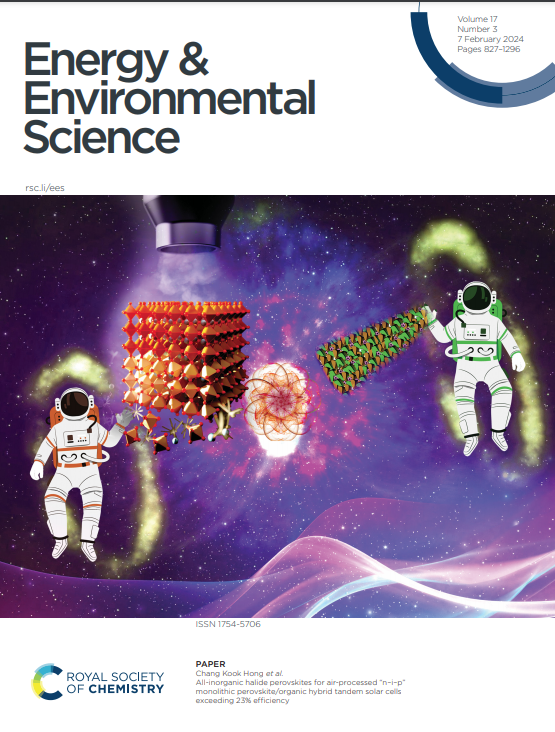Interfacial coordination utilizing chelating ligands for operationally stable perovskite solar modules
IF 32.4
1区 材料科学
Q1 CHEMISTRY, MULTIDISCIPLINARY
引用次数: 0
Abstract
Perovskite solar cells (PSCs) feature a higher maximum theoretical efficiency and a lower cost than silicon-based solar cells, while also offering additional advantages of being flexible and transparent. However, the commercialization of PSCs remains a great challenge due to rapidly degraded efficiency and stability when scaled up to industrial sizes. Here, we develop an interfacial coordination strategy utilizing chelating ligands to address both the efficiency and stability issues on large scale. The ligands can form a layer of Pb (II) coordination polymers with robust chemical bonds that not only effectively passivate surface defects but also serve as a tightly adhered capping layer for protecting the perovskite surfaces. Then, the as-fabricated solar module with an area of up to 31.6 cm2 exhibits a projected T80 lifetime of over 9,000 hours under 1-sun illumination at 25 °C. Moreover, the ligands introduce suitable energy levels between the perovskite and electron charge transport layer to facilitate charge transfer across the interface. As a result, we simultaneously achieve a power conversion efficiency of 25.0% for a 0.16 cm2 single cell, and 22.6% for a 31.6 cm2 module, comparable to the efficiencies achieved by state-of-the-art solar modules of similar sizes.利用螯合配体进行界面配位,实现运行稳定的过氧化物太阳能模块
与硅基太阳能电池相比,过氧化物太阳能电池(PSCs)具有更高的最大理论效率和更低的成本,同时还具有柔性和透明的额外优势。然而,由于在放大到工业规模时效率和稳定性会迅速下降,因此 PSCs 的商业化仍然是一个巨大的挑战。在此,我们开发了一种利用螯合配体的界面配位策略,以解决大规模应用时的效率和稳定性问题。配体可以形成一层具有牢固化学键的铅(II)配位聚合物,不仅能有效钝化表面缺陷,还能作为紧密粘附的封盖层保护包晶表面。然后,面积达 31.6 平方厘米的太阳能模块在 25 °C、1 个太阳光照射下的预计 T80 寿命超过 9,000 小时。此外,配体在过氧化物和电子电荷传输层之间引入了合适的能级,以促进电荷跨界面转移。因此,我们同时实现了 0.16 平方厘米单电池 25.0% 的功率转换效率和 31.6 平方厘米模块 22.6% 的功率转换效率,与类似尺寸的最先进太阳能模块的效率相当。
本文章由计算机程序翻译,如有差异,请以英文原文为准。
求助全文
约1分钟内获得全文
求助全文
来源期刊

Energy & Environmental Science
化学-工程:化工
CiteScore
50.50
自引率
2.20%
发文量
349
审稿时长
2.2 months
期刊介绍:
Energy & Environmental Science, a peer-reviewed scientific journal, publishes original research and review articles covering interdisciplinary topics in the (bio)chemical and (bio)physical sciences, as well as chemical engineering disciplines. Published monthly by the Royal Society of Chemistry (RSC), a not-for-profit publisher, Energy & Environmental Science is recognized as a leading journal. It boasts an impressive impact factor of 8.500 as of 2009, ranking 8th among 140 journals in the category "Chemistry, Multidisciplinary," second among 71 journals in "Energy & Fuels," second among 128 journals in "Engineering, Chemical," and first among 181 scientific journals in "Environmental Sciences."
Energy & Environmental Science publishes various types of articles, including Research Papers (original scientific work), Review Articles, Perspectives, and Minireviews (feature review-type articles of broad interest), Communications (original scientific work of an urgent nature), Opinions (personal, often speculative viewpoints or hypotheses on current topics), and Analysis Articles (in-depth examination of energy-related issues).
 求助内容:
求助内容: 应助结果提醒方式:
应助结果提醒方式:


